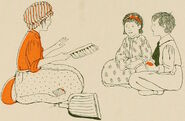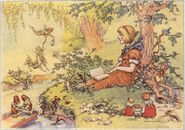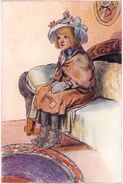“The Gobble‐uns’ll git you ef you don’t watch out!”
| Little Orphant Annie | |
|---|---|
 | |
|
Real name |
Mary Alice “Allie” Smith, Annie |
|
First appearance |
The Indianapolis Journal (30 Sept. 1882) |
|
Original publisher |
Indianapolis Journal Co. |
|
Created by |
James Whitcomb Riley |
Origin
Mary Alice Smith, a.k.a. Little Orphant Allie, is an orphan child who helps keep house for the kind family who have taken her in, and when work is done, tells chilling horror stories to her younger housemates. In her first appearance (“Where Is Mary Alice Smith?,” 1882), she tells the children a grisly story of murder by decapitation and then later introduces them to her soldier friend Dave who is soon killed upon going off to war. In her second appearance (“The Elf Child,” 1885), she tells them horror stories of misbehaving children who are abducted by goblins. According to Wikipedia, the character is popular with Indiana children, particularly at Halloween.
Reprints of the 1885 poem from 1889 on render the character’s name as Orphant Annie, by which she has become much better known and is her name in the derivative movie and storybook (Orphant is regional Indiana pronunciation of orphan or orphaned).
The 1918 movie Little Orphant Annie indicates that she had previously told her scary stories to fellow orphans in an orphanage, depicts her unfortunate family situation before moving to her benefactors’ home and illustrates two of her stories.
In 1921, author Johnny Gruelle further expanded Annie’s origin story in The Orphant Annie Story Book, which depicts in greater detail the winter day of her arrival at her benefactor family’s home. Gruelle goes to great lengths to cast a magic fairylike glow about her, describing her, for example, as “a strange, mysterious, fancy‐filled little girl” who “seemed to come direct from the Land of Fairies” and who “seemed a creature … whose place was with Gnomes and Elves as they formed their Fairy Rings and danced in the shimmering moonlight.” In addition to horror stories, she also tells much less frightening stories about fairies, gnomes, magicians and anthropomorphic animals.
Public domain literary appearances
- “Where Is Mary Alice Smith?”, by James Whitcomb Riley, The Indianapolis Journal, 30 Sept. 1882. Reprinted in book form in The Boss Girl, 1885. (Internet Archive)
- “The Elf Child,” by James Whitcomb Riley, The Indianapolis Journal, 15 Nov. 1885. Reprinted in book form in The Boss Girl, 1885. (Internet Archive)
- Reprinted as “Little Orphant Annie” in Old‐Fashioned Roses, 1889. (Internet Archive)
- Expanded version with additional stanzas in The Orphant Annie Book, 1908. (Internet Archive)
- “Little Orphant Annie,” music by Ward‐Stephens, 1916. (HathiTrust)
- Home Folks (play) (published in print as Little Orphan Annie: A Comedy‐Drama in Three Acts), by Robert McLaughlin, 1918. (HathiTrust)
- Orphant Annie Story Book, by Johnny Gruelle, 1921. (Google Books)
Public domain movie appearance
Little Orphant Annie, Selig Polyscope Company, 1918.
Notes
- The character is based on a real girl named Mary Alice Smith (1850–1924) who, similar to the character, lived in the author’s home and helped with housework.
- The public domain character Raggedy Ann was named after Little Orphant Annie in 1915, and the copyrighted character Little Orphan Annie was named after her in 1924.
- The original poem has been reprinted many times, often with illustrations. Any illustrations first published in editions in 1923 or later are not likely to be in the public domain, and elements of the character and of her appearance introduced in those illustrations may need to be avoided as well.
- The 1924 comic strip, radio show, stage musical and movie musical character Little Orphan Annie is certainly not in the public domain and has little in common with the 1889 Little Orphant Annie character beyond a name and orphanhood.















